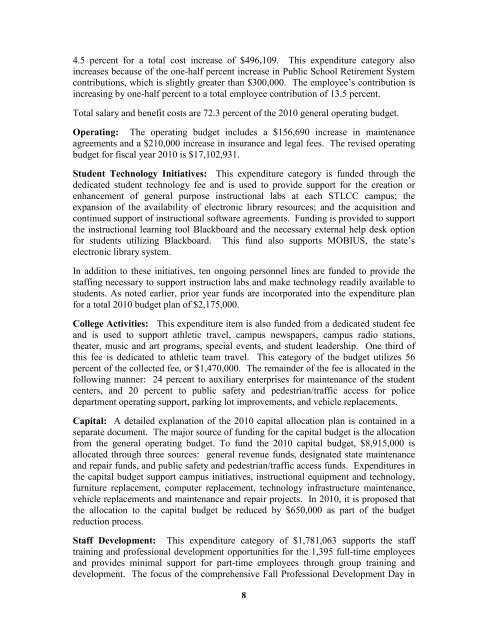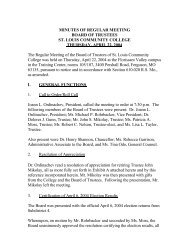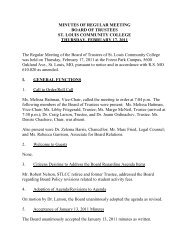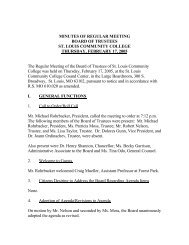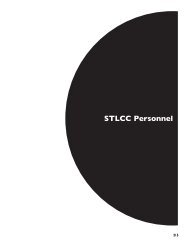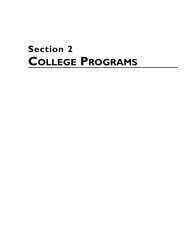SLCC Board of Trustees Meeting Minutes, June 25, 2009 - St. Louis ...
SLCC Board of Trustees Meeting Minutes, June 25, 2009 - St. Louis ...
SLCC Board of Trustees Meeting Minutes, June 25, 2009 - St. Louis ...
You also want an ePaper? Increase the reach of your titles
YUMPU automatically turns print PDFs into web optimized ePapers that Google loves.
4.5 percent for a total cost increase <strong>of</strong> $496,109. This expenditure category also<br />
increases because <strong>of</strong> the one-half percent increase in Public School Retirement System<br />
contributions, which is slightly greater than $300,000. The employee’s contribution is<br />
increasing by one-half percent to a total employee contribution <strong>of</strong> 13.5 percent.<br />
Total salary and benefit costs are 72.3 percent <strong>of</strong> the 2010 general operating budget.<br />
Operating: The operating budget includes a $156,690 increase in maintenance<br />
agreements and a $210,000 increase in insurance and legal fees. The revised operating<br />
budget for fiscal year 2010 is $17,102,931.<br />
<strong>St</strong>udent Technology Initiatives: This expenditure category is funded through the<br />
dedicated student technology fee and is used to provide support for the creation or<br />
enhancement <strong>of</strong> general purpose instructional labs at each STLCC campus; the<br />
expansion <strong>of</strong> the availability <strong>of</strong> electronic library resources; and the acquisition and<br />
continued support <strong>of</strong> instructional s<strong>of</strong>tware agreements. Funding is provided to support<br />
the instructional learning tool Blackboard and the necessary external help desk option<br />
for students utilizing Blackboard. This fund also supports MOBIUS, the state’s<br />
electronic library system.<br />
In addition to these initiatives, ten ongoing personnel lines are funded to provide the<br />
staffing necessary to support instruction labs and make technology readily available to<br />
students. As noted earlier, prior year funds are incorporated into the expenditure plan<br />
for a total 2010 budget plan <strong>of</strong> $2,175,000.<br />
College Activities: This expenditure item is also funded from a dedicated student fee<br />
and is used to support athletic travel, campus newspapers, campus radio stations,<br />
theater, music and art programs, special events, and student leadership. One third <strong>of</strong><br />
this fee is dedicated to athletic team travel. This category <strong>of</strong> the budget utilizes 56<br />
percent <strong>of</strong> the collected fee, or $1,470,000. The remainder <strong>of</strong> the fee is allocated in the<br />
following manner: 24 percent to auxiliary enterprises for maintenance <strong>of</strong> the student<br />
centers, and 20 percent to public safety and pedestrian/traffic access for police<br />
department operating support, parking lot improvements, and vehicle replacements.<br />
Capital: A detailed explanation <strong>of</strong> the 2010 capital allocation plan is contained in a<br />
separate document. The major source <strong>of</strong> funding for the capital budget is the allocation<br />
from the general operating budget. To fund the 2010 capital budget, $8,915,000 is<br />
allocated through three sources: general revenue funds, designated state maintenance<br />
and repair funds, and public safety and pedestrian/traffic access funds. Expenditures in<br />
the capital budget support campus initiatives, instructional equipment and technology,<br />
furniture replacement, computer replacement, technology infrastructure maintenance,<br />
vehicle replacements and maintenance and repair projects. In 2010, it is proposed that<br />
the allocation to the capital budget be reduced by $650,000 as part <strong>of</strong> the budget<br />
reduction process.<br />
<strong>St</strong>aff Development: This expenditure category <strong>of</strong> $1,781,063 supports the staff<br />
training and pr<strong>of</strong>essional development opportunities for the 1,395 full-time employees<br />
and provides minimal support for part-time employees through group training and<br />
development. The focus <strong>of</strong> the comprehensive Fall Pr<strong>of</strong>essional Development Day in<br />
8


